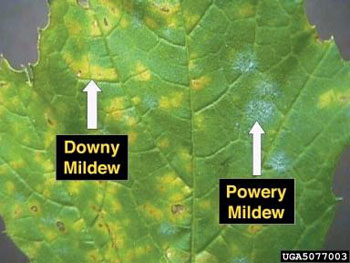Symptoms Management Causes More Info
Damon Smith, Oklahoma State University
Symptoms
Symptoms will vary depending on the age of leaf tissue. New leaves infected by downy mildew often develop yellow lesions that look oily. More mature tissues have an angular lesion that is yellow to reddish-brown and limited by leaf veins. On the lower leaf surface, a cottony growth ( mycelium) is often readily apparent. Viewing mature mycelium under the microscope will reveal the sporulating structures (sporangia connected to tree-like sporangiophores) of the organism. These structures give rise to motile spores (zoospores) that can cause secondary infections. Downy mildew overwinters primarily as thick-walled survival spores (oospores) in fallen leaves but also can survive as mycelium in buds.
Cultural Management Options
Any practice that reduces moisture in the vineyard — including improving soil drainage, orienting vineyard rows with the prevailing wind, and maintaining adequate weed control to increase air flow — will help reduce the severity of downy mildew. Proper dormant pruning and sanitation are imperative to reduce the number of spores. Destroy all plant material removed from the vineyard.
Chemical Management Options
Fungicides should be applied as soon as possible after an infection event is assumed to have occurred (i.e., if temperatures are between 50ºF and 85ºF, prevailing humidity has been high, and there is a continuous wet period of 24 hours). The practice of fungicide rotation is extremely important for managing downy mildew, since it is a high-risk pathogen for the development of fungicide resistance. Take care to use several classes of fungicides in a downy mildew chemical control program, to prevent fungicide resistance from occurring. Consult with a county Extension office for current fungicide recommendations for grapes.
Causes
Downy mildew, caused by the fungal-like organism Plasmopara viticola, typically occurs in excessively wet and warm, but not hot, years. Rain events are considered the primary factor driving the disease. When humid nights are followed by rain events the next day, the risk is high for downy mildew infection. Temperature also plays a role, but downy mildew can grow in temperatures of 50ºF to 85ºF, with optimal temperatures from 65ºF to 72ºF. Most severe epidemics have been noted when wet winters are followed by wet springs and warm summers with rain events occurring every eight to 14 days. The pathogen attacks all green parts of the vine and often causes significant premature defoliation. If serious enough, this can cause sufficient stress to plants, making them prone to other diseases or disorders such as winter injury. Downy mildew is most damaging when factors exist that increase the moisture of soil, air, and the host plant.
Recommended Resources
Downy Mildew, Michigan State University
Downy Mildew of Grape, University of Illinois
Midwest Small Fruit and Grape Spray Guide
Field Guide for Integrated Pest Management in Pacific Northwest Vineyards, Washington State University
Video on Downy Mildew, Cornell University
Video: Downy Mildew of Grape, University of Kentucky
Reviewed by Bruce Bordelon, Purdue University and Eric Stafne, Mississippi State University

